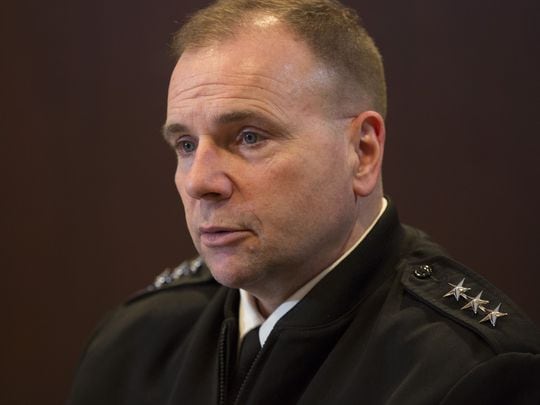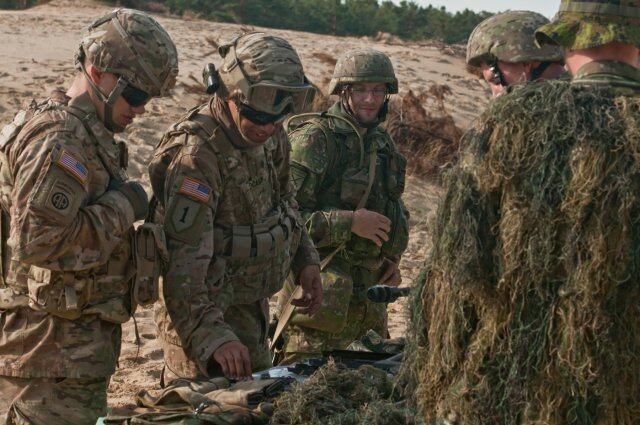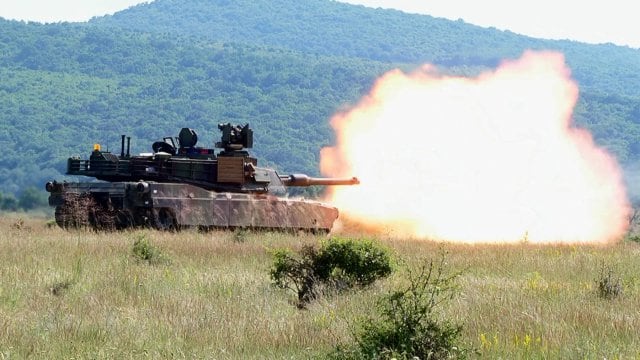The Army must rely on more rotational forces as well as the National Guard and Army Reserve as it prepares to expand its training mission in Ukraine and continue reassuring its European allies in the face of Russian aggression.
"We've only got 30,000 [soldiers]," said Lt. Gen. Ben Hodges, commanding general of U.S. Army Europe. "We've got to make it look and feel like 300,000."
The Army has ratcheted up its activities across Europe in a bid to reassure America’s NATO allies since Russia’s invasion of Ukrainian territory in February 2014. One of the most visible efforts is Operation Atlantic Resolve, a series of exercises that has grown to span more than a half-dozen half a dozen countries including the three Baltic Sstates, Poland, Romania and Bulgaria.
The Army also is looking to send a second brigade's worth of tanks, Bradleys and other heavy equipment to the region, and dedicate an entire division to exercises, training and assurance missions across Europe.
The renewed emphasis on Europe comes as the Army continues a massive drawdown of forces that has already cut 10,000 soldiers — including two brigade combat teams — from Europe. Another 1,700 soldiers will be cut over the next three years as part of the latest round of reductions, leaving about 30,000 soldiers forward-stationed in Europe.
"I've got to get as much of the Guard and Reserve as we can," Hodges said during an interview with Army Times. "We've got to get better at using allied capability, and we've got to get the most out of the regionally aligned force."
Both units are based at Fort Carson, Colorado, so "there's a sort of synergy that'll come from them both being located there," Hodges said.
It is going to take some time, however, for the bulk of the 4th Infantry Division to be actively engaged in Europe. For now, just the headquarters has been is rotating into the region.
"All the brigades are already committed to other things," Hodges said. "Frankly, it's a great example of how the Army is committed all over the place. There are requirements everywhere for Army units."
Until then, Army Europe is relying on soldiers from 1st Brigade, 3rd Infantry Division, and an aviation battalion from Fort Stewart, Georgia.
"I would be completely unable to do what we're doing now if we did not have the 4th Division headquarters and if we did not have the heavy brigade and if we did not have the rotational aviation," Hodges said. "They are essential to us being able to provide the assurance and deterrence that we're doing."

Lt. Gen. Ben Hodges, commanding general of U.S. Army Europe, said his units have been stretched and his soldiers have faced increased operational tempo due to cutbacks and ramped-up activity in the region.
Photo Credit: Alan Lessig/Staff
"The Stryker unit, the miles that their vehicles are getting in a month is about six times what an NTC rotation would be," he said.
The highest demand for troops seems to be for movement control teams, Hodges said.
"We have very few of them, and in order to ensure freedom of movement, all these convoys and in and out rotations, we have taken out of hide movement control teams and put them in each of the embassies."
These soldiers work through issues such as diplomatic clearances and road movements.
Also in high demand are aviators, even as the Army reorganizes and shrinks the Europe-based 12th Combat Aviation Brigade, Hodges said.
The 12th CAB is one of three combat aviation brigades being cut as the Army downsizes.
"Aviation is stretched thin in terms of the number of aircraft," Hodges said. "The maintenance, a lot of maintenance is needed to keep aircraft in the sky, and they're not all flying out of one base."
The aviation capability in Europe is boosted by a rotational battalion from the 3rd Infantry Division at Fort Stewart, Georgia.
"That's given us half of the lift that we require to do what we're doing," Hodges said. "Their blade hours are more than if they were in Afghanistan, so it is a challenge."
The reduced size of the force also means putting more responsibility on the shoulders of young leaders — captains, lieutenants and noncommissioned officers.
"We don't have battalions and brigades all over the place," he said.
The young leaders "are doing a great job" but "it's not perfect, and it's higher risk."

Spc. Mixocoatl Ocampo, a gunner with Reaper Troop, 4th Squadron, 2nd Cavalry Regiment, learns about a Slovak weapon during Operation Slovak Shield last month at a small-arms range near Pelisky, Slovakia. The exercise took place as part of Operation Atlantic Resolve.
Photo Credit: Sgt. Juana M. Nesbitt/Army
In addition to Operation Atlantic Resolve — which will include 51 battalion or larger multinational exercises this year alone; "it's non-stop, this is going all the time," Hodges said. The Army is on its third training rotation in Ukraine.
Each Ukraine rotation is about two months long; this rotation is expected to be completed in early November.
U.S. troops began training Ukrainian forces in April, with soldiers from the 173rd Airborne Brigade Combat Team. Since the inception of Fearless Guardian, U.S. trainers have been joined by soldiers from Canada and Lithuania.
So far, the training has involved troops from Ukraine's interior ministry. In November, the training program will expand to include active-duty Ukrainian soldiers.
The plan is to train five battalions, one at a time, Hodges said. The soldiers will mostly focus on basic infantry company and battalion tasks, with emphasis on treating and evacuating casualties, and operating in a highly contested electronic warfare environment, he said.
"We've gotten better, we understand better," he said. "The Ukrainians see the value and the potential, so they've grown into it also."
As the program matures, soldiers from the 173rd ABCT will be replaced by soldiers from the California National Guard, Hodges said.
"It's unsustainable, doing what we're doing now," he said.
He anticipates the Guard soldiers will take over by the second or third battalion rotation.
The California Guard is partnered with Ukraine through the National Guard's long-time State Partnership Program.
"It's the beauty of the state partnership that you can draw from," Hodges said.

Army activity has increased in Europe as Russia's activities have created concerns in the region. Here, soldiers with 3rd Battalion, 69th Armor Regiment, participate in a tank shoot rehearsal at Novo Selo Training Area, Bulgaria, in June.
Photo Credit: Sgt. Alan Brutus/Army
Looking ahead, Hodges said the Army will continue to push forward with its training despite the budget cuts that have dogged the service for years.
"The current security environment is completely different from what we thought it was two years ago" when the first cuts in Europe were made, Hodges said. "Russia's not our friend, or they certainly are not acting like a friend."
One move that could help is if Operation Atlantic Resolve becomes a formally named operation, Hodges said.
"You get a formally named operation, you move up in priority for resources, for funding, access to the reserve component, those kinds of things," Hodges said. "And, of course, that would send a very powerful signal to the allies that we're trying to assure that we are very serious."
As the budget battle slogs on in Washington, D.C., the lack of "good, old reliable funding of the government" makes it "very difficult" for Army Europe to continue its mission, Hodges said.
"We're not talking about keeping the lights on at Fort Benning, Georgia, or Fort Campbell or Fort Hood. We're talking about big contracts for moving stuff around Europe on rail cars, ships, bringing things over, continuous operations," he said. "Every bit of that undermines our ability to provide the assurance and deterrence that our country signed up for."
The budget uncertainty also has a "terrible impact" on all the military services and their ability to "efficiently and effectively conduct operations and run the enterprise," Hodges said.
Michelle Tan is the editor of Army Times and Air Force Times. She has covered the military for Military Times since 2005, and has embedded with U.S. troops in Iraq, Afghanistan, Kuwait, Haiti, Gabon and the Horn of Africa.




